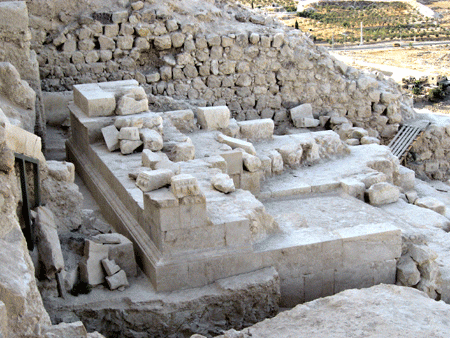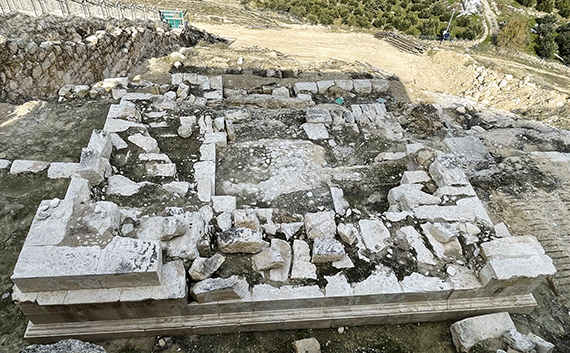|
|
|
 |
|
"Now when Jesus was born in
Bethlehem of Judea in the days of
Herod the king, behold wise men from the East came to Jerusalem,
Saying, ‘Where is he who has been born king of the Jews?
…Then Herod summoned the wise men to see him privately”
MATTHEW 2
|
|
|
 |
|
 |
| |
To which of
Herod’s palaces did he summon the Magi from
the east for a private conference? Was
it in the heart of Jerusalem, next to
today’s Jaffa Gate in the palace I dub
“Herod’s Hilton,” for it had up to 100 rooms
for his family and favored cronies? Or
was it to Herodion, his luxurious and isolated palace
out in the Judean wilderness, close to
Bethlehem, which he meticulously designed as
his future mausoleum?
We can’t know for sure. But if it was
to Herodion where the wise men were
summoned, they couldn’t help but compare
Herod's palace with its eastern tower an
equivalent of nine-stories high, its
state-of-the-art bath-room and elegant
colonnaded dining hall, to the humble surroundings in
which the Savior was born.
Had Herod been analyzed on Freud’s couch, we
might know the answer to why Herod, after
meeting the wise men, launched a vicious
campaign to kill all the male children under
two years old in the entire Bethlehem
region. (Matthew 2:16) |
| |
|
 |
|
Photo:
Gila Yudkin |
|
View of Herodion, the
conical-shaped mountain where King Herod was
buried |
| |
A careful
reading of first century AD historian
Josephus Flavius provides a number of clues
to Herod’s character. I’d be happy to
share these insights with you and your group
on site at Herodion. Once we hear even
a small selection of the “Herod horror
stories,” we’ll understand why the emperor
himself, Augustus Caesar, reportedly offered
this dubious compliment about Herod: “It’s
better to be Herod’s pig than his son!”
(It's a pun in Greek!)
Another of Herod’s contemporary detractors
had this to say about him: “He came to power
like a fox, ruled like a tiger and died like
a dog!” Josephus vividly enumerates
Herod’s debilitating diseases: he had
swollen feet, inflammation of the abdomen,
worms in his genitals, difficulty in
breathing, spasms in all his limbs and
uncontrollable itching. Josephus then
describes the elaborate funeral cortege
which carried Herod's body lying on a solid
gold bier adorned with precious stones and
draped with deep purple, from Jericho 24
miles to
Herodion where Herod was buried. |
| |
|
 |
|
Photo:
Gila Yudkin |
|
View of Herodion from the
colonnaded swimming pool |
| |
But where
was Herod’s tomb? The search went on for
over 150 years until May 2007 when Professor
Ehud Netzer of Jerusalem’s Hebrew University
publicly announced the discovery of Herod’s
tomb.
When I first visited Herodion with Professor
Netzer in 1981, the location of Herod’s tomb
was a tantalizing riddle. There were
at least seven theories of where it could
be. Professor Netzer at that time was
concentrating on Lower Herodion with its
monumental palace and spacious swimming
pool. Nearby, Netzer discovered a
large route, 350 yards long and 30 yards
wide, which had been especially prepared for
the funeral procession. During that
tour, Netzer showed us exactly where he
expected to find the tomb. But no luck.
Nada. |
| |
|
 |
|
Photo:
Gila Yudkin |
|
Netzer originally thought
Herod was buried near the lower palace
(foreground) |
| |
| Now, 26
years later, in the middle of the
artificially raised cone-shaped mountain,
Professor Netzer found the mausoleum.
It was almost totally dismantled in ancient
times, most certainly by the zealots
fighting Rome, who considered Herod a
vicious Roman lackey. The intricately
crafted sarcophagus itself was broken into
hundreds of pieces. Originally it had
been made of Jerusalem red-tinted limestone
and decorated with rosettes.
Archeologists at the site have unfortunately
not found an inscription. But two additional
sarcophagi have been discovered. |
| |
|
 |
|
Photo:
Barbara Kreiger |
|
Sitting on the podium of
Herod's mausoleum in June 2007 |
| |
|
 |
|
Photo:
Gila Yudkin |
|
More of Herod's mausoleum
exposed at Herodion in September 2008 |
| |
| Since the
discovery I have visited Herodion ten times,
and in my mind, there’s no doubt about it:
it is Herod’s tomb! This is a very
exciting discovery, mostly because of the
inordinately long search. Professor
Ehud Netzer and his team are still on site,
hunting for more evidence. |
| |
|
 |
|
Photo:
Gila Yudkin |
|
Professor Ehud Netzer (figure on left) at
the excavation of Herod's mausoleum |
| |
| |
| In November
2008, I attended a press conference where
Herod’s sarcophagus was exhibited along with
other impressive fragments of urns, which
had once adorned Herod’s first century (4
BC) tomb. Professor Netzer showed us
drawings of terraced gardens which had once
surrounded the ornate tomb monument. |
| |
|
 |
|
Photo:
Gila Yudkin |
|
Ehud Netzer posing by what
he presumes to be King Herod's sarcophagus |
| |
|
 |
|
Photo:
Gila Yudkin |
|
Sarcophagus found at
Herodion, possibly of Herod's 6th wife,
mother of Archelaus |
| |
Another
surprise was the discovery to the west of
the mausoleum of an intimate theater seating
300 spectators along with a
loggia, a royal box where Herod could
watch performances with his closest cronies.
(If he had any, that is!) This VIP viewing
and hospitality room was decorated with
brightly colored wall paintings and plaster
moldings in a style never seen before in the
holy land.
On your next pilgrimage, come with me to
Herodion which has it all: stunningly stark
desert vistas, a just-solved archeological
riddle, cistern-tunnels for the adventurers
to explore, and a link to the birth
narrative in the Gospel of Matthew. |
| |
| March
2021 UPDATE |
| |
| During the
pandemic when there were no tourists in the
land, I returned to Herodion just after the
loggia, the "royal box" was opened to
the public. The theater had been
restored and the steps mentioned by Josephus
Flavius which once led up to the Upper
Palace had been reconstructed. |
| |
| I will
contrast some of my earlier photos taken
after the discovery of the tomb and the
previously unknown theater with my 2021
photos. |
| |
|
 |
|
Photo:
Gila Yudkin |
|
Newly excavated theater at
Herodion in 2009 |
| |
|
 |
|
Photo:
Gila Yudkin |
|
Shed covering the ongoing
theater excavations of the Royal Room in 2009 |
| |
|
 |
|
Photo:
Gila Yudkin 2021 |
|
Reconstructed "royal box"
above the theater with the hill of the Upper
Palace behind |
| |
|
 |
|
Photo:
Gila Yudkin |
|
Ehud Netzer showing a
journalist friend and me the ancient wall paintings
in 2009 |
| |
|
 |
|
Photo:
Gila Yudkin |
|
The same corner of the
Royal Room after restoration/conservation in
2021 |
| |
|
 |
|
Photo:
Gila Yudkin |
|
Restored decoration on the
opposite wall of the Royal Room as seen in
2021 |
|
Note a fragment of the
stuccowork frieze in the upper portion of
the pilaster |
|
|
 |
|
Photo:
Gila Yudkin |
|
Wall painting in the style
of a "hanging window" with an Egyptian motif |
|
The crocodile and palm
tree symbolize Augustus' victory over
Cleopatra |
| |
|
 |
|
Photo:
Gila Yudkin |
|
The original stairs
leading from the theater to the Upper Palace
were exposed in 2011 |
|
"It [the fortress] has a
steep ascent of 200 stairs of hewn stone,"
Josephus writes |
| |
|
 |
|
Photo:
Gila Yudkin |
|
Ascending to Herodion
(safely!) via the ancient steps in 2021 |
| |
|
 |
|
Photo:
Gila Yudkin 2021 |
|
Podium of Herod's Tomb
with a model based upon a similarity to
Absalom's Tomb |
| |
|
See "Let's
revisit Herod's Mausoleum at Herodion"
for my memories of Ehud Netzer after his
tragic death in October 2010. |
|
|
|
February
2023 photos |
|
|
|
 |
|
Photo:
Gila Yudkin 2023 |
|
Podium of Herod's Tomb
taken from the 2000-year-old steps (facing
east) |
|
|
|
 |
|
Photo:
Gila Yudkin 2023 |
|
View of the podium of
Herod's Tomb facing south-west |
|
|
|
Gila Yudkin,
who calls herself a Connecticut-born Yankee
living now in King David's court, has been
shepherding pilgrims in the Holy Land for
over a quarter of a century. She hasn’t yet
lost one stray – at least not permanently!
It’s recommended you contact Gila while you
are planning your pilgrimage to ensure that
your itinerary is feasible, inspiring and
allows for biblical adventures. |
| |
If archeology enthralls you, consider
reading “Shepherds,
Scholars and Scrolls” about the
discovery of the Dead Sea Scrolls in 1947.
David, as a young boy, would certainly have
practiced with his slingshot right below the
hill later called Herodion as he was
protecting his father’s sheep. An
ideal gift for someone who wants to slay his
giants is the “Traditional
Slingshot that Killed Goliath,”
woven by a woman from Bethlehem.
|
| |
|
Copyright 2008, 2009, 2013, 2021, 2023 Gila Yudkin. Permission
needed for any reuse. |
|
|
|
GILA
YUDKIN
•
TCHERNIKOVSKI
64A
•
JERUSALEM
•
ISRAEL
gila@itsgila.com
HOME
•
HOLY
LAND
HEROINES
•
TIPS
FOR TOURS •
ABOUT GILA
|
|

